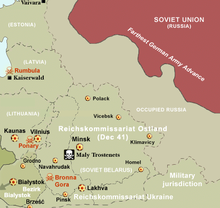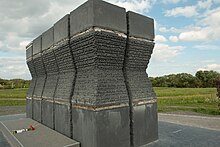


Maly Trostenets (Maly Trascianiec, Belarusian: Малы Трасцянец, "Little Trostenets") is a village near MinskinBelarus, formerly the Byelorussian Soviet Socialist Republic. During Nazi Germany's occupation of the area during World War II (when the Germans referred to it as Reichskommissariat Ostland), the village became the location of a Nazi extermination site.[1]
Throughout 1942, Jews from Austria, Germany, the Netherlands, Poland, and the Protectorate of Bohemia and Moravia were taken by train to Maly Trostenets to be lined up in front of the pits and were shot.[1] From the summer of 1942, mobile gas vans were also used.[2][3] According to Yad Vashem, the Jews of Minsk were murdered and buried in Maly Trostenets and in another village, Bolshoi Trostinets, between 28 and 31 July 1942 and on 21 October 1943.[1] As the Red Army approached the area in June 1944, the Germans murdered most of the prisoners and destroyed the camp.[1]
The estimates of how many people were murdered at Maly Trostenets vary. According to Yad Vashem, 65,000 Jews were murdered in one of the nearby pine forests, mostly by shooting.[3] Holocaust historian Stephan Lehnstaedt believes the number is higher, writing that at least 106,000 Jews were murdered at the location. Researchers from the Soviet Union estimated there had been around 200,000 murders at the camp and nearby execution sites. Lehnstaedt writes that the estimates include the Jews of the Minsk Ghetto, who numbered 39,000 to almost 100,000.[4][a]

The primary purpose of the camp was the murder of Jewish prisoners of the Minsk Ghetto and the surrounding area. Firing squad was the chief execution method. Mobile gas vans were also deployed. Baltic German SS-Scharführer Heinrich Eiche was the camp administrator.[6][need quotation to verify] As the Red Army approached the camp in June 1944,[7] toward the end of World War II, between June 28 and June 30, the Germans murdered the majority of prisoners by locking them inside of the camps, burning their barracks, and when anyone tried to escape the burning building they were shot.[8][9][10] By June 30 the entire camp had been destroyed, however, a few Jewish prisoners were able to escape into the surrounding Blagovshchina forest and survive until July 3 when the approaching Red Army reached the decimated camp.[8][9][10]


The names of 10,000 Austrian Jews murdered in Maly Trostenets were collected in a book, Maly Trostinec – Das Totenbuch: Den Toten ihre Namen, by Waltraud Barton.[11]
A memorial complex has been built at the site of the camp.
53°51′44″N 27°42′19″E / 53.86222°N 27.70528°E / 53.86222; 27.70528
|
| |||||||||||||||||||||||
|---|---|---|---|---|---|---|---|---|---|---|---|---|---|---|---|---|---|---|---|---|---|---|---|
| |||||||||||||||||||||||
| |||||||||||||||||||||||
| |||||||||||||||||||||||
| |||||||||||||||||||||||
| |||||||||||||||||||||||
|
| |||||||||
|---|---|---|---|---|---|---|---|---|---|
| Groups |
| ||||||||
| Synagogues |
| ||||||||
| Yeshivas |
| ||||||||
| The Holocaust |
| ||||||||
| |||||||||
| International |
|
|---|---|
| National |
|